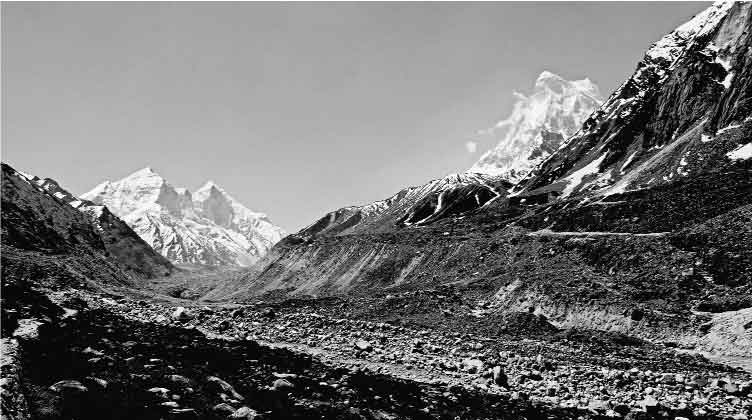Deb Mukharji has been traversing mountains for six decades and, for him, trekking and taking pictures have been parallel exercises
Most serious photographers have love affairs. The subjects can range over a wide spectrum from people, events, unfolding action to cities, forests, the wilderness, lakes, oceans and mountains. William Henry Jackson (1843-1942) was in love with the American West and his photographs helped to set up the Yellowstone National Park sprawling over the states of Wyoming, Montana and Idaho. Carleton Watkins (1829-1916) loved the Yosemite and his shots of it, taken in 1861, perhaps contributed more than anything else to the United States’ Congress’s decision to constitute the valley into a national park. Ansel Adams (1902-1984), whose photographs of Yosemite like the Half Dome, under the Moon, El Capitan in winter, Merced river under the Cathedral Rock cliff and the Mirror Lake with the Half Dome in the background have become iconic, was also known for his love of the Sierra Nevada mountains in California. It was his book of photographs of them that strongly influenced President Franklin Delano Roosevelt’s decision to establish the Kings Canyon National Park in southern parts of the range in California’s Fresno and Tulane counties.
In India, too, photographic exploration of the Himalaya mountains began in the 19th century. In three expeditions to the mountain between 1863 and 1866, Samuel Bourne — of the famous Bourne and Shephard studios in Kolkata, Simla and Mumbai (then Bombay) and by all accounts not a very nice person — collected a large number of prints that brought him reputation and money. John Claude White, an engineer by training and a political officer in sensitive areas of Nepal, Bhutan, Sikkim and Tibet by employment, was an avid photographer. He has left behind striking images of Kanchenjunga, glaciers on the Langpo Valley, Siniolchu at 22,370 feet in Sikkim and so on.
A number of other examples can be cited. In our time, Deb Mukharji, a retired member of the Indian Foreign Service, has been in love with mountains and has, for the last 60 years, combined a passion for high altitude trekking with photography. His footfalls have ranged from Uttarakhand, Himachal Pradesh and Sikkim in India to Nepal, China’s Tibet Autonomous region and places like Yosemite. The result has been an enormous collection of images, 75 of which have recently been on display in an exhibition entitled ‘Tall Tales from the Himalaya’ at the India International Centre’s Kamaladevi Complex in New Delhi. Mostly in black-and-white, but some in colour, these are generally stunning, and some breathtaking.
To say that light is the most critical element in photography is to emphasise the obvious. Even shadows are creations of light, being the products of obstacles to its flow, and would not have existed without it. Light, however, matters more in the mountains where it becomes the defining elements of photography, affecting the colours of the three principal components of a landscape — snow, the mountains and the clouds. The former, bathed in a reddish glow at pre-dawn, and turning pink and golden as the day progresses, acquires a dazzling luminosity when the Sun is in mid-sky, once again increasingly turns crimson with the evening until it sets behind the mountain crests.
Besides snow, mountains have the changing colours of the forests, from deep to faded green, and their stark and craggy flanks of bare stone. The clouds have their own colours ranging from the very dark, almost black, to slate grey and white when it is bright, and sometimes even glowing, but does not dazzle and radiate light like snow. They have their own sizes and shapes — small and resembling giants’ powder puffs to masses blotting out the sky.
Not surprisingly, mountains provide multitudinous arresting images, brought to life by the play of light and shadows — contrasting and contrapuntal. Of course, with apologies for using a much-used cliché, everything depends on the photographer. Like all genres of photography, the one relating to mountains has its unique set of demands — physical fitness among them. Treks can be taxing and hazardous. As important is the ability to use light. Taking advantage of “the golden hour”, which is immediately before dawn and sunset respectively, is a part of it. Varying light and shadows cast by meandering clouds can lend a touch of magic to any scene at any time. This is where the need for a discerning eye, which tells a person at a glance what should be in his/her camera frame, becomes critically relevant. Without it, one could pass by the subject of an iconic photograph without noticing.
Deb Mukharji has been traversing mountains for six decades and, for him, trekking and photographing have been parallel exercises. As his photographs of Siniolchu, of a miniature forest on the trunk of a tree in a dense jungle in Garwhal and of a view from the Valley of Flowers and so on, show, he has an excellent understanding of what light does and how he can use it to his advantage. And he had to have a finely-honed photographer’s eye to produce the images he has. His achievements are all the more significant because unlike many other photographers who patiently wait to take pre-determined shots, he shoots while trekking. But then eternal alertness is a pre-requisite of good photography.
(The writer is Consultant Editor, The Pioneer, and an author


























